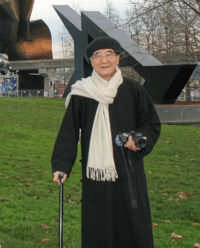Han Pao-teh
Han Pao-teh (Chinese: 漢寶德; pinyin: Hàn Bǎodé; 19 August 1934 – 20 November 2014) was a Taiwanese architect, educator and curator.
Han Pao-teh Han Pao Teh | |
|---|---|
漢寶德 | |
 Han in 2006 | |
| Born | 19 August 1934 |
| Died | 20 November 2014 (aged 80) Taipei, Taiwan |
| Nationality | Republic of China |
| Alma mater | Tainan Institute of Technology Harvard University Princeton University |
| Occupation | Architect |
| Spouse(s) | Sharon Hsiao Han 蕭中行 (m.1965- died 1995) Nina Sun 孫寧瑜 (m.1999-2014) |
| Children | Karen Han 漢可凡 Joseph Han 漢述祖 |
| Parent(s) | Father 漢榮青 Mother 李建蕙 |
| Awards | Executive Yuan Culture Award |
Han Pao-teh (Han Pao Teh) was born in Shandong, China and moved to Taiwan in 1949. He received his bachelor's degree in Architecture from the Tainan Institute of Technology, now known as the National Cheng Kung University.[1] He was awarded a full scholarship to attend Harvard University, where he received a master's degree in Architecture in 1965. And in 1967, he received his second master's degree in Art History at Princeton University.
He was invited to returned to Taiwan in 1967, and was appointed the Chair of the Department of Architecture at Tunghai University in Taichung, where he introduced a new system of education during his 10-year tenure. He was the Dean of the College of Science and Engineering at National Chung Hsing University from 1977 to 1981. In the late 70's he was credited to be the pioneer in the movement for the preservation of historic buildings in Taiwan . He personally researched and directed the restoration projects of many important historical landmarks, including Changhua Confucius Temple , Lukang Longshan Temple , and the Lin Family Mansion in Banqiao.[2]. Records and slides of his restoration projects including research and documentation are in the archives of the Department of Architecture at Tunghai University.
During 1981–1986, Han Pao-teh was appointed by the Executive Yuan to lead the preparation and design of National Museum of Natural Science in Taichung. This is the first museum of its kind in Taiwan. He was appointed by the Ministry of Education to be its first Director from 1987 to 1995. This museum is now the 18th most visited museums worldwide, only one place behind Musee d'Orsay in Paris .In 1993, Han Pao-teh was appointed by the Ministry of Education to design, build and establish Tainan National University of the Arts (TNNUA). He served as the first president/chancellor of TNNUA 1996-2000, and elected program chair of the graduate school of Museum Studies in 1996. He was a prolific author and columnist, published over 40 books. Majority of his hand written drafts can be found in the archives of the Taiwan National Central Library.
In 2000, after his retirement from TNNUA, Han Pao-teh was invited by the Ling Jiou Mountain Buddhist Foundation to be the first director and curator of the Museum of World Religions. During 1998–2001, he was also the director of National Culture and Arts Foundation. He was an accomplished Chinese Calligrapher, culminated in multiple personal exhibitions in museums and galleries in Taiwan.
Han Pao-teh was appointed presidential advisor, the Geheimrat of Presidential Office in Taiwan from 2001 until his death in 2014.
Han Pao-teh died in Taipei, Taiwan, on 20 November 2014. He was posthumously given the Executive Yuan Culture Award, the nation's highest honor for persons with great contribution to art and culture of Taiwan.[3]
Han is commemorated in the scientific name of a species of Vietnamese lizard, Takydromus hani.[4]
Works of architecture
Representative works designed by Han Pao-teh include:
- Tiansiang Youth Activity Center (1978), Taroko Gorge, Hualien County
- Changhua Cultural Center (1981), Changhua County
- Institute of Ethnology (1985), Academia Sinica
- Tainan National University of the Arts (1996)
- Nan Yuan (South Garden) (1985) - Jiangnan-style architecture and landscaped gardens in Hsinpu, Hsinchu County, was for many years a very exclusive area for the use of top-echelon officers of the United Daily News (UDN).[5]
- Kengting Youth Activity Center (1983), Kenting
Major publications
- Han Pao-Teh, Han Pao-Teh's Narrative about Cultures, Artouch, 2006. ISBN 986-7519-84-1.
- Han Pao-Teh, A Walk in European Architectures, Ecus Publishing House, 2005.
- Han Pao-Teh, The Memoir of Han Pao-Teh, Book Zoom, 2004. ISBN 957-621-909-4.
- Han Pao-Teh, Han Pao-Teh's Narrative about Aestheticism, Linkingbooks, 2004. ISBN 957-08-2703-3.
- Han Pao-Teh, Expatiating on Architecture, Hebei Education Press, 2003. ISBN 7-5434-5034-8.
- Han Pao-Teh, Looking into Architecture, Artbook, 2002. ISBN 986-7957-40-7.
- Han Pao-Teh, Exhibition Planning: Theory and Practice, Archi, 2000. ISBN 957-8440-98-7.
- Han Pao-Teh, Recent Reflections on Architecture and Culture, National Museum of History, 1995. ISBN 957-00-5923-0.
- Han Pao-Teh, The Story of Chinese Landscape Design: External Forms and Internal Visions, Art Media Resources, Ltd., 1992. ISBN 978-957-530-356-3.
- Han Pao-Teh, Museum Management, Garden City Publishers, 1990. ISBN 957-8440-96-0.
- Han Pao-Teh, The Spiritual Dimensions of Architecture, Architecture Informations, 1971. ISBN 957-0454-31-8.
- Han Pao-Teh, Architecture, Society and Culture, Architecture Informations, 1971. ISBN 957-0454-11-3.
References
- Kelly Her (November 2007). "A Postmodern Traditionalist". Taiwan Today. Vol. 57 no. 11.
- Dingbo Wu (1994). Handbook of Chinese Popular Culture. Greenwood Publishing Group. pp. 341–. ISBN 978-0-313-27808-2.
- "Executive Yuan honors contributors to national culture". Taipei Times. 26 November 2014. Retrieved 26 December 2016.
- Beolens, Bo; Watkins, Michael; Grayson, Michael (2011). The Eponym Dictionary of Reptiles. Baltimore: Johns Hopkins University Press. xiii + 296 pp. ISBN 978-1-4214-0135-5. ("Han", p. 115).
- "Archived copy". Archived from the original on 2013-08-24. Retrieved 2013-06-29.CS1 maint: archived copy as title (link)